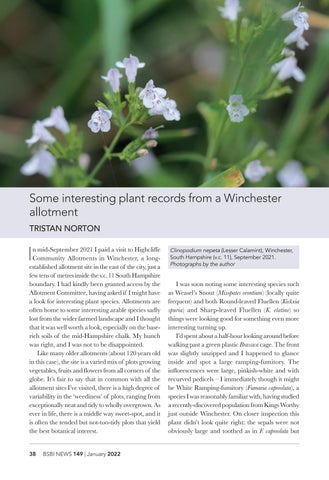Some interesting plant records from a Winchester allotment TRISTAN NORTON
I
n mid-September 2021 I paid a visit to Highcliffe Community Allotments in Winchester, a longestablished allotment site in the east of the city, just a few tens of metres inside the v.c. 11 South Hampshire boundary. I had kindly been granted access by the Allotment Committee, having asked if I might have a look for interesting plant species. Allotments are often home to some interesting arable species sadly lost from the wider farmed landscape and I thought that it was well worth a look, especially on the baserich soils of the mid-Hampshire chalk. My hunch was right, and I was not to be disappointed. Like many older allotments (about 120 years old in this case), the site is a varied mix of plots growing vegetables, fruits and flowers from all corners of the globe. It’s fair to say that in common with all the allotment sites I’ve visited, there is a high degree of variability in the ‘weediness’ of plots, ranging from exceptionally neat and tidy to wholly overgrown. As ever in life, there is a middle way sweet-spot, and it is often the tended but not-too-tidy plots that yield the best botanical interest. 38
BSBI NEWS 149 | January 2022
Clinopodium nepeta (Lesser Calamint), Winchester, Soam H htu psheri (vc. . 11),September1.20 Photographs by the author
I was soon noting some interesting species such as Weasel’s Snout (Misopates orontium) (locally quite frequent) and both Round-leaved Fluellen (Kickxia spuria) and Sharp-leaved Fluellen (K. elatine) so things were looking good for something even more interesting turning up. I’d spent about a half-hour looking around before walking past a green plastic Brassica cage. The front was slightly unzipped and I happened to glance inside and spot a large ramping-fumitory. The inflorescences were large, pinkish-white and with recurved pedicels – I immediately though it might be White Ramping-fumitory (Fumaria capreolata), a species I was reasonably familiar with, having studied a recently-discovered population from Kings Worthy just outside Winchester. On closer inspection this plant didn’t look quite right: the sepals were not obviously large and toothed as in F. capreolata but












